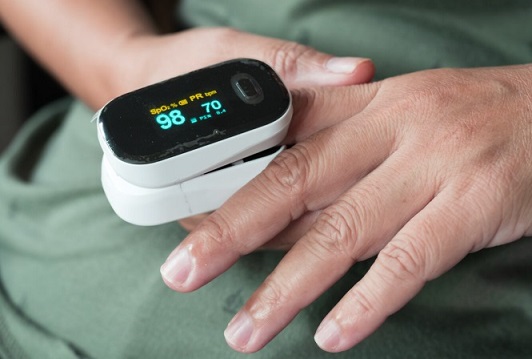Blood Oxygen Levels (SpO2) Offer New Insights on Resilience in Acute COVID-19 Patients
Nikhil Prasad Fact checked by:Thailand Medical News Team Feb 03, 2025 10 months, 4 days, 19 hours, 15 minutes ago
Medical-News:
Understanding Patient Resilience in the Fight Against COVID-19
Medical researchers from Radboud University Medical Center in the Netherlands have uncovered a novel way to assess how COVID-19 patients respond to acute health stressors. Their latest study explores the use of dynamic biomarkers to evaluate patient resilience through continuous monitoring of blood oxygen levels (SpO2). This groundbreaking approach could significantly impact how clinicians predict outcomes and manage care for those battling severe COVID-19 infections.
This
Medical News report delves into the key findings of this study, which focuses on how fluctuations in oxygen saturation reflect a patient’s ability to recover from health challenges. By measuring these fluctuations over time, researchers have developed new biomarkers that could predict whether a patient is likely to recover or experience adverse hospital outcomes such as intensive care unit (ICU) admission or death.
 Blood Oxygen Levels (SpO2) Offer New Insights on Resilience in Acute COVID-19 Patients
The Study and Its Methodology
Blood Oxygen Levels (SpO2) Offer New Insights on Resilience in Acute COVID-19 Patients
The Study and Its Methodology
The research team analyzed data from 200 hospital admissions involving 181 adults diagnosed with COVID-19. These patients underwent continuous blood oxygen monitoring, which allowed researchers to assess their ability to maintain stable oxygen levels. The study introduced two dynamic biomarkers to evaluate resilience:
-Resilience Exponent (α): This metric measures how frequently a patient experiences prolonged drops in oxygen levels. A higher α value indicates better resilience and a greater ability to maintain stable SpO2 levels.
-Oxygen (O2) Challenge Response: This assesses how a patient’s SpO2 reacts to changes in oxygen supplementation. Patients whose oxygen levels rapidly improve with additional oxygen may actually have worse outcomes, indicating an underlying instability in oxygen regulation.
To determine the effectiveness of these biomarkers, researchers conducted statistical analyses comparing the resilience metrics with patient outcomes. They found that patients with a higher resilience exponent (α) had significantly lower odds of adverse outcomes. On the other hand, those who exhibited large fluctuations in SpO2 in response to oxygen supplementation were at greater risk of ICU admission or death.
Key Findings on Patient Resilience and COVID-19 Outcomes
The study uncovered several important insights:
-Higher resilience exponent (α) is linked to better outcomes: Patients with fewer prolonged drops in SpO2 had a 41% lower risk of ICU admission or death. This suggests that those with stronger physiological resilience are more likely to recover from COVID-19 complications.
-Greater SpO2 increases after oxygen supplementation predict poorer outcomes: While it might
seem counterintuitive, patients whose SpO2 levels increased significantly after receiving oxygen had a 40% higher likelihood of an adverse outcome. This may indicate that their bodies struggle to maintain stable oxygen levels without external support.
-Frequent oxygen level adjustments signal higher risk: Patients requiring multiple increases in oxygen supplementation were nearly three times more likely to have a severe outcome, while those who experienced more decreases in oxygen supplementation were more likely to recover.
These findings suggest that continuous monitoring of SpO2 provides valuable real-time data on a patient’s ability to maintain stability. Unlike traditional static measures - such as age, sex, or medical history - these new dynamic biomarkers give clinicians a clearer picture of how a patient is responding to treatment.
What This Means for COVID-19 Treatment and Patient Care
The implications of this research are far-reaching. By integrating continuous SpO2 monitoring into routine hospital care, doctors may be able to detect early warning signs of deterioration before a patient requires intensive care. This could allow for more proactive interventions and potentially save lives.
For instance, instead of relying solely on one-time SpO2 readings or a patient’s overall medical history, hospitals could implement real-time resilience tracking. If a patient exhibits a low resilience exponent or an unstable O2 challenge response, doctors could intervene earlier with targeted treatments or closer monitoring.
Additionally, this approach could extend beyond COVID-19 care. Similar methods might be used to assess resilience in patients with other respiratory conditions, such as pneumonia or chronic obstructive pulmonary disease (COPD). By shifting from a static view of patient health to a dynamic, data-driven model, medical professionals can improve outcomes for a wide range of critical illnesses.
Moving Forward with Dynamic Biomarkers
While this study presents promising results, further research is needed to refine these biomarkers and validate their effectiveness in different hospital settings. Future studies should explore how these metrics perform in larger patient populations and whether they can be integrated into hospital monitoring systems on a broader scale.
Moreover, researchers hope to investigate additional factors that influence patient resilience, such as pre-existing conditions, medication use, and immune system responses. By building a more comprehensive model of resilience, they aim to enhance personalized treatment strategies for critically ill patients.
Conclusion
This study highlights the potential of dynamic biomarkers as a game-changer in hospital care. The ability to monitor and quantify resilience in real-time offers a new layer of insight that could transform how doctors manage COVID-19 and other acute illnesses. As medical technology advances, continuous SpO2 monitoring could become an essential tool for improving patient outcomes and reducing the burden on intensive care units.
The study findings were published in the peer-reviewed: Journal of Clinical Medicine.
https://www.mdpi.com/2077-0383/14/3/951
For the latest COVID-19 News, keep on logging to Thailand
Medical News.
Read Also:
https://www.thailandmedical.news/news/assessing-peripheral-and-organ-perfusion-to-identify-high-risk-covid-19-patients
https://www.thailandmedical.news/news/new-non-human-primate-study-alarmingly-reveals-that-sars-cov-2-infections-can-lead-to-brain-inflammation,-brain-hypoxia,-brain-bleeding-and-also-strok
https://www.thailandmedical.news/news/covid-19-hypoxia-new-research-provides-possible-explanations-for-%E2%80%98happy-hypoxia%E2%80%99-phenomenon-in-covid-19-patients
https://www.thailandmedical.news/articles/coronavirus
